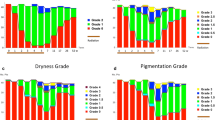Abstract
Background
The temperature of the skin remains elevated long after breast-conserving treatment with irradiation, perhaps because evaporative cooling is impaired. We investigated physiological changes of the irradiated skin and reevaluated the radiosensitivity of sweat glands on a functional basis to determine whether severe complications can be predicted.
Methods
Breast and axillary skin temperatures were measured with thermography and sweat production in response to local thermal stimuli was measured on the basis of changes in electrical skin resistance with a bridge circuit in 45 women before, during, and after breast irradiation for breast cancer.
Results
Breast and axillary skin temperatures were significantly increased after irradiation. In response to cutaneous thermal stimuli, the electric skin resistance of nonirradiated areas decreased significantly because of sweating, but that of irradiated areas was unchanged.
Conclusion
Impairment of sweating may play an important role in skin damage after irradiation. Although glandular tissue is not usually radiosensitive, the results of our functional assessment suggest that sweat glands are more radiosensitive than expected.
Similar content being viewed by others
Abbreviations
- BCT:
-
Breast-conserving surgery combined with radiotherapy
- TLD:
-
Thermoluminescence dosimeter
- ESRL:
-
electrical skin resistance level
References
Archambeau JO, Pezner R, Wasserman T: Pathophysiology of irradiated skin and breast.Int J Radiat Oncol Biol Phys 31:1171–1185, 1995.
FajardoL-G LF: Morphology of radiation effects on normal tissues. In: Perez CP, Brady LW, Principles and Practice of Radiation Oncology, 3rd ed, Lippincott-Raven Publishers, Philadelphia, ppl43–154, 1998.
Richter, CP: Physiological factors involved in the electrical resistance of the skin.Am J Physiol 88:596–615, 1929.
Darrow CW: Considerations for evaluating galvanic skin reflex.Am J Psychiat 13:285–298, 1933.
Wang GH: The galvanic skin reflex. A review of old and recent works from a physiologic point of view.Am J Physic Med :295–320, 1957; 37:35–57, 1958.
Borak J: The radiation biology of the cutaneous glands.Radiology 27:651–655, 1936.
Benediktsson KP, Celebioglu F, Perbeck LG: Influence of radiation therapy on skin circulation in breast after breast conservative surgery.Acta Oncologica 36:715–718, 1997.
Inomata T, Ogawa Y, Nishioka A,et al: Changes in blood flow and skin reaction following radiation therapy.Nippon Igaku Hoshasen Gakkai-Zasshi 55:58–64, 1995 (in Japanese with English abstract).
Mossman KL: Quantitative radiation dose-response relationships for normal tissues in man. II. Response of the salivary glands during radiotherapy.Radiation Research 95:392–398, 1983.
Hagbarth KE, Hallin, RG, Hongell A,et al: General characteristics of sympathetic activity in human skin nerves.Acta Physiologica Scandinavia 84:164–176, 1972.
Ogawa T, Bullard RW: Characteristics of subthreshold sudomotor neural impulses.J Appl Physiol 33:300–305, 1972.
Bini G, Hagbarth KE, Hynninen P,et al: Thermoregulatory and rhythm-generating mechanisms governing the sudomotor and vasoconstrictor outflow in human cutaneous nerves.J Physiol 306:537–552, 1980.
Bini G, Hagbarth KE, Hynninen P,et al: Regional similarities and differences in thermogegularoty vaso-and sudomotor tone.J Physiol 306:553–656, 1980.
Ogawa T: Basic knowledge on mechanisms of sweating for clinical tests.Journal of Clinical and Experimental Medicine (IGAKU NO AYUMI) 140:413–417, 1987 (in Japanese).
Umeyama T, Numata K, Wakasugi B,et al: Psychological and thermal perspiration in the judgement of effectiveness of stellate ganglion block.Pain Clinic 12:189–192, 1991 (in Japanese).
Author information
Authors and Affiliations
About this article
Cite this article
Sekine, H., Kobayashi, M., Honda, C. et al. Skin reactions after breast-conserving therapy and prediction of late complications using physiological functions. Breast Cancer 7, 142–148 (2000). https://doi.org/10.1007/BF02967446
Received:
Accepted:
Issue Date:
DOI: https://doi.org/10.1007/BF02967446




